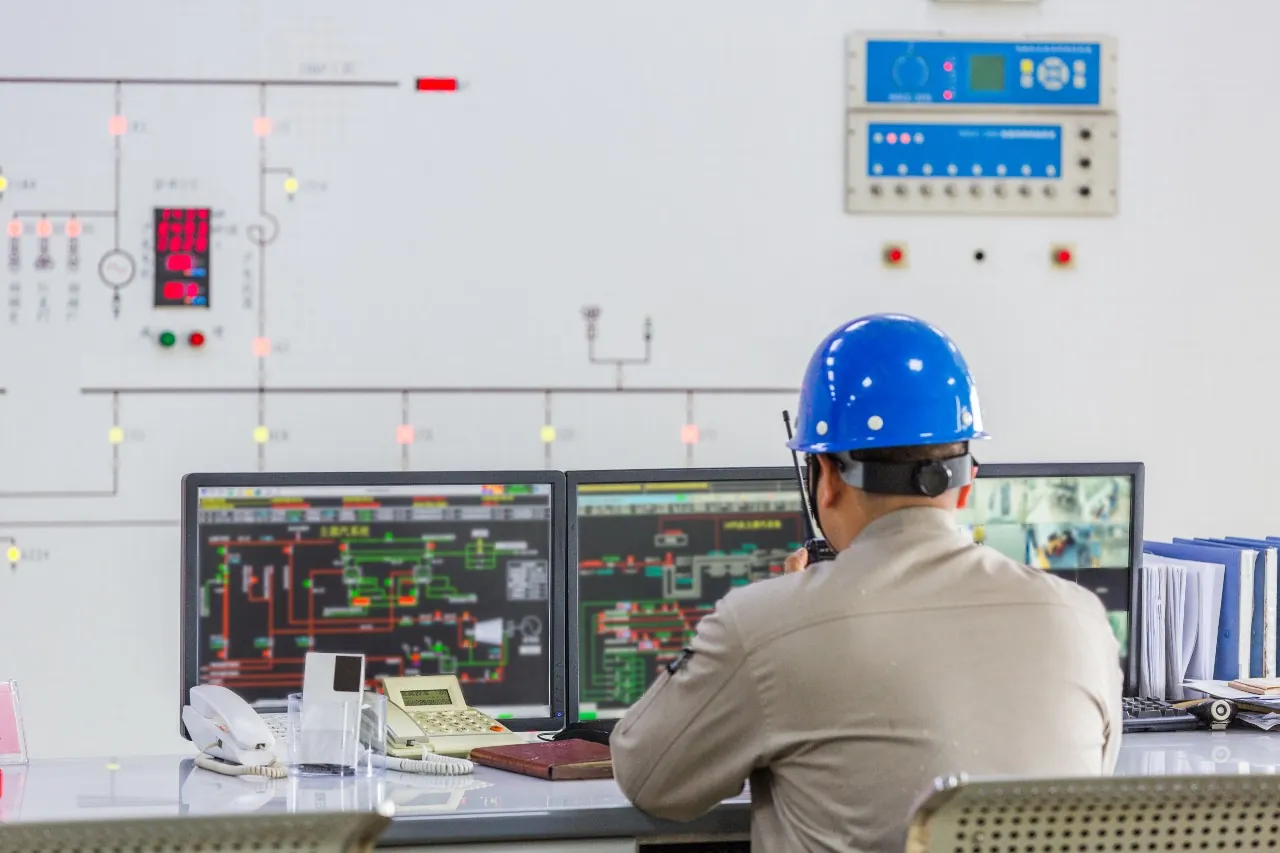PLCs (programmable logic controllers) and SCADA systems (supervisory control and data acquisition) are both important in modern industrial automation. They help control, monitor, and improve processes in industries like manufacturing, energy, and water. PLCs handle real-time control tasks based on signals from field devices and sensors. On the other hand, SCADA systems supervise, acquire data, and analyze information at a higher level. Together, they act as the backbone of many industrial operations, making sure there’s less need for people to intervene. This, in turn, reduces manual errors, ensures safety, and allows remote supervision for quick data-based decisions.
This article will dig into the details of PLC and SCADA systems. We’ll look at their parts, programming languages, how they communicate, and where they’re used. We’ll also talk about the difference between PLC and SCADA systems, how they work together, and what future trends are shaping the world of industrial automation.
What is a PLC?
PLC stands for “programmable logic controller.” It’s a device that is installed to keep an eye on system sensors, collecting data and important information about how the system is running.
A PLC can also take simple actions, activating outputs when it reaches certain pre-programmed limits. It’s a handy piece of hardware that can handle tough conditions where advanced features and real-time use are needed. For example, PLCs can manage complicated processes in industries, like keeping an eye on motors and machinery.
These devices are adaptable and easy to program, so they work well in many different situations. Modern PLCs were made to upgrade the older relays and timers that were used in industrial machines before.
What is SCADA?
SCADA stands for Supervisory Control and Data Acquisition. It’s usually software on a computer and acts as a link between people and industrial machines through something called a human-machine interface (HMI). Simply put, it lets users keep an eye on information from equipment, give commands, and tweak their programming.
SCADA systems often work with PLCs and other equipment. Information from PLCs and remote terminal units (RTUs) goes into the system, and through the HMI, users can make changes to how these processes work. It’s a smart way to keep everything in check and make adjustments when needed.
What is the Difference Between PLC and SCADA?
Think of a big factory with lots of machines. To keep everything running smoothly, you need two key things: a PLC and SCADA.
The PLC acts as the brain. It manages different parts of the machines to ensure they perform the right actions at the right times. On the other hand, SCADA is like the overseer, mainly existing as software or computer programming. It keeps a close watch on everything happening in the organization. Some might say SCADA is not just software; it’s like the manager of the entire factory, using both hardware and software.
In simpler terms, they collaborate in factories, each with its role. PLC takes care of controlling the machines, while SCADA keeps a vigilant eye on everything.
Now, let’s break down their roles in a straightforward table.
PLC vs SCADA
| Aspect | PLC (Programmable Logic Controller) | SCADA (Supervisory Control and Data Acquisition) |
|---|---|---|
| Definition | PLC is a specialized device employed for monitoring and controlling industrial processes. | SCADA is a graphical user interface designed to allow operators to access and monitor industrial processes efficiently. |
| Components | PLC consists of input and output modules integral to controlling specific industrial plant functions. | SCADA lacks input and output modules; instead, it acts as an interface between PLCs and operators, facilitating data exchange. |
| Relationship | PLCs are frequently utilized in conjunction with SCADA systems for enhanced control and monitoring capabilities. | SCADA serves as an intermediary, connecting PLCs and operators, and managing the flow of data between them for comprehensive control. |
| Scope | PLC is primarily geared towards the control and monitoring of specific machinery or equipment. | SCADA extends its functionality to oversee and control entire industrial processes across extensive geographical areas. |
| Operation Speed | PLC operates in real-time, featuring high-speed processing for precise control of industrial processes. | SCADA offers a broader perspective, not only in real-time but also by providing historical data for a comprehensive understanding of the process dynamics. |
| Logic Complexity | PLCs are versatile and capable of implementing logic ranging from simple to highly complex control strategies. | SCADA, while not directly involved in control logic, excels in monitoring and visualizing the intricate data generated by the control logic implemented in PLCs. |
| Design | PLCs are designed with a compact and robust build, ensuring suitability for challenging industrial environments. | SCADA is a software-based solution that can be installed on industrial-grade computers, providing a flexible and scalable platform for visualization. |
| Independence | PLCs can operate independently or as integral components within larger automation systems. | SCADA offers an overarching view of plant operations, contributing to decision-making for operators, but relies on the data generated by PLCs. |
| Cost-effectiveness | PLCs are often considered a cost-effective solution, particularly for small to medium-sized operations. | SCADA is deployed in operations of varying sizes, offering a more comprehensive but potentially higher-cost solution, justified by its extensive functionalities. |
Applications of PLC and SCADA
PLC and SCADA systems are super useful in lots of industries to control and manage processes better. Let’s look at how they’re used.
- What happens: In producing things like cars or technology, PLCs and SCADA help control machines and keep an eye on how things are going.
- How: PLCs handle individual machines, and SCADA watches everything, helping workers see how machines are doing and fix any problems.
- What happens: For electricity and water, PLCs and SCADA manage how power is made and pushed out and how water is distributed to homes.
- How: PLCs control machines like generators, and SCADA watches over everything, helping operators keep track of what’s happening and make smart decisions.
- What happens: PLCs and SCADA make sure our water is clean and waste is treated properly.
- How: PLCs control pumps and filters and SCADA keeps an eye on the whole process, helping operators see how everything is working and fix any issues.
PLC and SCADA systems team up in different industries, making sure things run smoothly and helping people make smart decisions about how to manage everything. This makes these systems essential when it comes to monitoring and controlling processes to a greater, more efficient degree.
How do PLC and SCADA Work Together?
When PLC and SCADA work together, they create an automated system to schedule maintenance tasks, forming the heart of a predictive maintenance plan. Here’s how it works:
- Information from sensors on different assets goes to the PLC.
- The PLC changes that data into a format the software can use.
- Users can see the data through the software’s HMI.
- A maintenance work order is made when the data hits certain limits
For example, if a turbine is vibrating too much, the sensors send that data through the system. On the user’s end, the information triggers a maintenance work order. In this setup, the SCADA software manages the whole system, and the PLCs act as points for relaying information and controllers for specific assets.
How Does a CMMS Integrate with SCADA and PLC?
Linking CMMS software with sensors, PLCs, SCADA, and other systems lets you keep an eye on an asset’s condition in real-time. This helps identify potential issues before they become problems, diagnose any existing problems, and plan maintenance proactively.
In industrial settings, combining CMMS and SCADA improves maintenance and monitoring. A CMMS assists in planning and recording maintenance tasks, while SCADA offers instant insights into equipment and processes. When these systems work together, maintenance teams can prioritize tasks using SCADA data, focusing on equipment conditions and performance.
If you’d like to know more about using NEXGEN with PLCs and SCADA, click the link below to schedule a demo with us today.
Frequently Asked Questions (FAQs)
-
What is the difference between PLCs and SCADA systems?
PLCs are the go-to for real-time control, handling individual devices or small processes. Meanwhile, SCADA systems take a broader approach, concentrating on overseeing, gathering data, and analyzing information for more extensive industrial processes.
-
Can you combine PLCs and SCADA systems?
Absolutely! Merging PLC and SCADA systems comes with perks like more efficient control and monitoring of industrial processes. It’s a smart move for making better decisions and optimizing how things run.
-
Which fields rely on PLCs and SCADA systems?
PLCs and SCADA systems find homes in diverse industries, from manufacturing and energy to water management and distribution.
-
What are some emerging trends and technologies of PLCs and SCADA systems?
Current trends include linking up with the Internet of Things (IoT), embracing cloud-based SCADA systems, and bringing in artificial intelligence and machine learning for smoother operations.
-
How is DCS different from SCADA?
Distributed control system (DCS) gets hands-on with real-time control, making sure everything in a process is just right. In contrast, SCADA leans more towards gathering data, creating visual representations, and overseeing processes from a distance.






